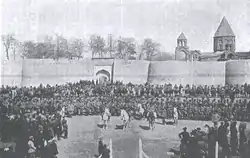Hamazasp Srvandztyan
Hamazasp Srvandztyan (Armenian: Համազասպ Սրվանձտյան; 1873 – 18 February 1921), commonly known as Hamazasp, was an Armenian fedayee military commander and member of the Armenian Revolutionary Federation.[1]
Hamazasp Srvandztyan | |
|---|---|
 | |
| Birth name | Hamazasp Srvandztyan |
| Nickname(s) | Hamazasp |
| Born | 1873 Van, Ottoman Empire |
| Died | 18 February 1921 (aged 47–48) Yerevan, Soviet Armenia |
| Allegiance | |
| Service/ | Russian Armenian Volunteer Corps |
| Years of service | 1890s—1920 |
| Commands held | 3rd Armenian volunteer battalion |
| Battles/wars | Armenian National Liberation Movement Armenian–Tatar War World War I |
Early life
Hamazasp was born in Van in 1873. He was the nephew of the folklorist Garegin Srvandztiants. Hamazasp was first a member of the Armenakan Party and then the Armenian Revolutionary Federation. After finishing school he began to learn handicraft as a jeweler and a watchmaker. From an early age he was involved in the Armenian national liberation movement. To avoid persecution by the Ottoman government, he moved to Yerevan, then to Shusha from Van.[1]
He participated in the Armenian–Tatar clashes of 1905–07. Hamazasp was especially notable in the Battle of Askeran Ravine on 22 August 1905, defeating a 200-member Turkish detachment of which only 6 survived. He also organized the defense of the Armenian villagers of the Elisabethpol Governorate. In 1908, the Tsarist government arrested Hamazasp and condemned him to death, but this was replaced by a 15 years of exile to Siberia sentence. In 1913 he escaped from prison and went to Europe, then to Constantinople. At the 8th General Assembly of the ARF party that took place in Karin in 1914, he was strongly opposed to any cooperation with the Young Turks,[1] and largely supported an alliance with the Russian Empire.[2]
World War I

At the beginning of the First World War, Hamazasp participated in the Caucasus Campaign and was appointed Commander of the 3rd Armenian volunteer battalion. He took part in many battles, and also ensured the safe migration of the Armenian population from Basen and Alashkert. He was one of the volunteer liberators of the Siege of Van in May 1915. In June he fought in the Battle of Bitlis, and in October fought in Hizan. After the February Revolution in 1917, Hamazasp was appointed the military police commander of Alashkert, until Russian troops left the Caucasian front.[1]
At the end of April 1918, a group of Armenian soldiers under the command of Hamazasp was sent by Shaumian from Baku to the Kuba Uyezd. Here, the Hamazasp squad carried out a brutal massacre of the inhabitants of the city of Kuba, and also burned down 122 villages of the Kuba Uyezd. In one day, only in Kuba Hamazasp's soldiers killed 2,000 residents of the city and destroyed 150 houses in its center.[3]
In 1918, he fought for the Baku Commune, as a Commander of the Armenian brigade (3,000 soldiers and officers).[4] He displayed his abilities as an experienced strategist and organizer, playing a decisive role in the operations of Ganja and Yevlakh and for 4 months fought against overwhelming Turkish forces of the Army of Islam. After the fall of the Baku Commune, he went to Persia.[1]
First Republic of Armenia
.JPG.webp)
In the autumn of 1918, after the defeat of Turkey in the First World War, Hamazasp came back to Armenia and was appointed military commander of the region of Nor Bayazet. He participated in various actions of defense of the First Republic of Armenia, including the suppression of the May Uprising in 1920.[1]
After the establishment of the Soviet power in Armenia, Hamazasp came to Yerevan with the aim of being helpful for the new government. However, he was arrested by the Bolsheviks and, after two months of imprisonment, he was brutally hacked to death on 18 February, 1921, when the February Uprising was on the way.[1]
References
- Y. Gasparyan (1996). Encyclopedia "The Armenian Issue". Yerevan.
- Vratsian, Simon (1960). Keankʻi ughinerov Volume II. Beirut: Hamazkayin. pp. 228, 229.
- Jörg Baberowski. Der Feind ist überall. Stalinismus im Kaukasus. — München: Deutsche Verlags-Anstalt, 2003. — P. 141. — ISBN 3-421-05622-6. (in German). Citation: Ende April bewegte sich eine größere Streitmacht von 2 000 armenischen Soldaten unter Führung des Obristen Amazasp und des bolschewistischen Kommissars Venunc von Baku aus auf Kuba zu. Amazasp kam im Auftrag Saumjans und des Kriegskommissars Korganov nach Kuba, um ein Exempel an der Konterrevolution zu statuieren. Als der Kriegsherr mit seinen Soldaten in die Stadt ritt, ließ er keinen Zweifel an seinen Absichten. Er sei »als Held des armenischen Volkes« gekommen, um die Massaker der Türken an seinen Landsleuten zu rächen und »alle Muslime vom Meeresufer bis zum Sach Dagh zu vernichten«, wie er den versammelten Stadtbewohnern verkündete. So geschah es auch. Die armenischen Soldaten gerieten in einen Blutrausch. Sie töteten alle Muslime, die sie auf der Straße antrafen. Dann drangen sie in die Häuser ein und ermordeten ihre Bewohner. Auf den Straßen spielten sich furchtbare Exzesse ab: Kleinkinder wurden erschossen, Babys enthauptet, man schlitzte Männern die Bäuche auf und stach ihnen die Augen aus. Soldaten vergewaltigten Frauen in Gegenwart ihrer Ehemänner, zahlreiche Frauen verbrannten bei lebendigem Leib in ihren Häusern. Das Eigentum der Stadtbewohner wurde auf die Straße geworfen, Wertgegenstände aus den Häusern getragen und unter den Soldaten verteilt. Sie rasende Soldateska ermordete an einem Tag 2 000 Stadtbewohner und zerstörte 150 Gebäude im Zentrum der Stadt. Bereits auf dem Vormarsch nach Baku hinterließ das Regiment des Amazasp eine Spur der Verwüstung: 122 Dörfer im Kreis Kub gingen in Flammen auf, Bauern, die den anrükkenden Truppen mit weißen Fahnen entgegenschritten, wurden niedergeschossen.
- "Events of March 1918 in Baku: how it was in reality". vestnikkavkaza.net. March 31, 2015. Retrieved August 9, 2015.
